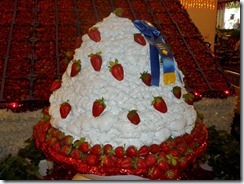I can see colors fine except when I have to write them in a story. Then I’ll say a character has brown eyes, is wearing a green top with khakis, and has her nails painted red. What is wrong with this picture? Rainbow colors don’t do justice to the myriad of shades out there. So how do you get more specific? Here are some helpful aids. Think in categories.
Jewels—pearl, amethyst, emerald, ruby, sapphire, jade
Flowers—rose, lilac, daffodil, lavender

Food—grape, cherry, orange, lemon, lime, cocoa, coffee, fudge, chocolate, blueberry, avocado, strawberry
Minerals—onyx, copper, gold, silver, malachite, cobalt
Nature—slate gray like a thundercloud, leaf green, walnut, coal, ivory
But sometimes my mind goes blank, and so I turn to the most creative resource of all—a department store catalog. You can’t get any more imaginative than this, whether it’s towels or tops or sweaters. Here are some descriptive colors from a recent newspaper insert:
Heather gray, apple green, aquatic blue, berry, coral, cornflower blue, charcoal, navy, banana, raspberry, tropical turquoise, sky blue, stone gray, violet, burgundy, claret, evergreen, marine teal, sand, ocean aqua, pewter, snow.
You get the idea. And so I’ve created a file listing descriptive adjectives under each basic rainbow color. Here is one example:
BROWN
chestnut, auburn, mahogany, walnut, hazel, fawn, copper, camel, caramel, cinnamon, russet, tawny, sand, chocolate, maroon, tan, bronze, coffee, rust, earth, dusty, mud, toffee, cocoa
Thus when I am stuck for a particular shade, I can hop over to my color chart and pick one out.
Colors descriptions also convey emotions. For example, mud brown, toad green, or cyanotic blue have a less pleasant connotation than chocolate brown, sea green or ocean blue. So choose your hues carefully to enhance a scene.
What’s your secret to describing colors?




Nancy, the department store catalog is a great tip. One of the best descriptions of color I’ve ever read is by Thomas Harris: as blue as a meat inspector’s stamp. You know immediately what color he’s talking about.
Yes, Joe, that’s an unusual one. It’s hard to think up original color analogies.
Great post, Nancy.
You realize that men have a higher incidence of color blindness than women? I know, that’s red vs. green. But I think men also are more color illiterate than women. I put on a shirt and walk out to my wife. “Do these go together?”
Anyway, I could imagine what some of my buddies would say if they walked into my office and saw a department store catalog lying on my desk opened up to the women’s dresses – “mint taffy chiffon.”
I like your file listing for each rainbow color. I could hide that from view.
Maybe someone will write THE POSITIVE COLOR THESAURUS and THE NEGATIVE COLOR THESAURUS. Or better yet, COLORS FOR (MEN) DUMMIES.
Thanks for the post. I’m off to start that color file.
Likely it’s true that men don’t describe fashions in stories as much as women or hair color and such. But I’ll bet you can describe a car’s finish just fine, right?
Good point. Colors from the POV character’s world and experience.
The only thing I can add is to make sure whatever color you pick comes from your character’s POV. Not to man-bash here, but I don’t think I would buy some dude in a mystery describing a woman’s dress as “teal.” Shoot, I’m not even sure what teal is! I just finished a chapter where I have my character Louis describe a sheriff’s eyes as the color of the Gulf during a storm. (He lived on the beach in Captiva and has recently returned to snowy Michigan so his memories of his former home are very ripe in his consciousness.)
If you are writing a child’s POV or a younger person, they might also see colors differently than an adult. And yes, it’s scientific fact, that woman can discern SHADES more subtly than men. Which can be fun to play with as a writer.
You make a valid point. All descriptions should be in the character’s POV. Since my mysteries are always in Marla’s head, that’s no problem for me unless her husband Dalton is speaking. But he’s a cop, so he might be more particular about colors in describing a suspect’s vehicle or apparel. But he still wouldn’t use more specific shades like a woman.
Sometimes the color names are too obscure, but paint chips offer creative ideas.
Yes, this is true. In fact, we’re going to get our house exterior painted and I’m waiting for the painter to bring around his color chips.
Do you have one for tastes too? I always get hung up on these, lol.
Sorry, I don’t have one for tastes. That would be harder. Sweet, salty, or sour?